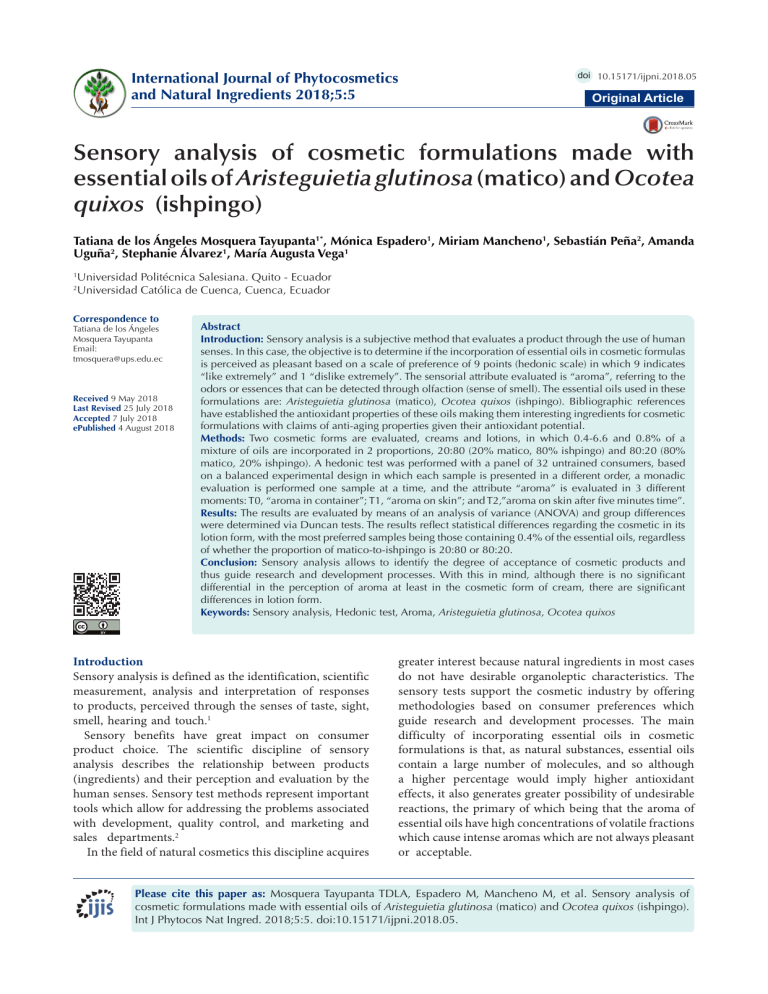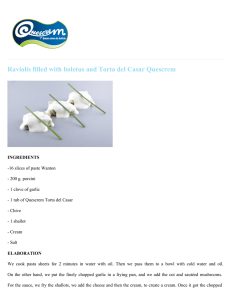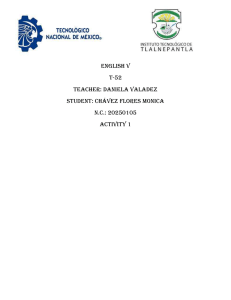
International Journal of Phytocosmetics and Natural Ingredients 2018;5:5 doi 10.15171/ijpni.2018.05 Original Article Sensory analysis of cosmetic formulations made with essential oils of Aristeguietia glutinosa (matico) and Ocotea quixos (ishpingo) Tatiana de los Ángeles Mosquera Tayupanta1*, Mónica Espadero1, Miriam Mancheno1, Sebastián Peña2, Amanda Uguña2, Stephanie Álvarez1, María Augusta Vega1 Universidad Politécnica Salesiana. Quito - Ecuador Universidad Católica de Cuenca, Cuenca, Ecuador 1 2 Correspondence to Tatiana de los Ángeles Mosquera Tayupanta Email: tmosquera@ups.edu.ec Received 9 May 2018 Last Revised 25 July 2018 Accepted 7 July 2018 ePublished 4 August 2018 Abstract Introduction: Sensory analysis is a subjective method that evaluates a product through the use of human senses. In this case, the objective is to determine if the incorporation of essential oils in cosmetic formulas is perceived as pleasant based on a scale of preference of 9 points (hedonic scale) in which 9 indicates “like extremely” and 1 “dislike extremely”. The sensorial attribute evaluated is “aroma”, referring to the odors or essences that can be detected through olfaction (sense of smell). The essential oils used in these formulations are: Aristeguietia glutinosa (matico), Ocotea quixos (ishpingo). Bibliographic references have established the antioxidant properties of these oils making them interesting ingredients for cosmetic formulations with claims of anti-aging properties given their antioxidant potential. Methods: Two cosmetic forms are evaluated, creams and lotions, in which 0.4-6.6 and 0.8% of a mixture of oils are incorporated in 2 proportions, 20:80 (20% matico, 80% ishpingo) and 80:20 (80% matico, 20% ishpingo). A hedonic test was performed with a panel of 32 untrained consumers, based on a balanced experimental design in which each sample is presented in a different order, a monadic evaluation is performed one sample at a time, and the attribute “aroma” is evaluated in 3 different moments: T0, “aroma in container”; T1, “aroma on skin”; and T2,”aroma on skin after five minutes time”. Results: The results are evaluated by means of an analysis of variance (ANOVA) and group differences were determined via Duncan tests. The results reflect statistical differences regarding the cosmetic in its lotion form, with the most preferred samples being those containing 0.4% of the essential oils, regardless of whether the proportion of matico-to-ishpingo is 20:80 or 80:20. Conclusion: Sensory analysis allows to identify the degree of acceptance of cosmetic products and thus guide research and development processes. With this in mind, although there is no significant differential in the perception of aroma at least in the cosmetic form of cream, there are significant differences in lotion form. Keywords: Sensory analysis, Hedonic test, Aroma, Aristeguietia glutinosa, Ocotea quixos Introduction Sensory analysis is defined as the identification, scientific measurement, analysis and interpretation of responses to products, perceived through the senses of taste, sight, smell, hearing and touch.1 Sensory benefits have great impact on consumer product choice. The scientific discipline of sensory analysis describes the relationship between products (ingredients) and their perception and evaluation by the human senses. Sensory test methods represent important tools which allow for addressing the problems associated with development, quality control, and marketing and sales departments.2 In the field of natural cosmetics this discipline acquires greater interest because natural ingredients in most cases do not have desirable organoleptic characteristics. The sensory tests support the cosmetic industry by offering methodologies based on consumer preferences which guide research and development processes. The main difficulty of incorporating essential oils in cosmetic formulations is that, as natural substances, essential oils contain a large number of molecules, and so although a higher percentage would imply higher antioxidant effects, it also generates greater possibility of undesirable reactions, the primary of which being that the aroma of essential oils have high concentrations of volatile fractions which cause intense aromas which are not always pleasant or acceptable. Please cite this paper as: Mosquera Tayupanta TDLA, Espadero M, Mancheno M, et al. Sensory analysis of cosmetic formulations made with essential oils of Aristeguietia glutinosa (matico) and Ocotea quixos (ishpingo). Int J Phytocos Nat Ingred. 2018;5:5. doi:10.15171/ijpni.2018.05. Mosquera Tayupanta et al http://www.ijpni.org The sensory characteristics of cosmetic products are very important to the process of consumer choice, acceptance, and loyalty. Consumer preference for a specific product among many is firstly a function of their perception of a product’s packaging, and subsequently that of its smell, appearance and texture (tactile senses).3 The development of a new cosmetic product is a longterm process consisting of several phases: formulation, quality tests, evaluation of efficacy, and safety tests.4,5 Independently of the effect that a product may have on skin,6 it is necessary to specifically consider consumer preferences during the development phases of a cosmetic product. Sensory analysis becomes much more important when the ingredients that make up a product are of natural origin because these plants produce and emit many volatile organic compounds. The smell these compounds produce, which are released not only from flowers and fruits but also from vegetative tissues, have always been recognized for their commercial and aesthetic importance. For more than 2 decades, the influence exerted by these aromas on numerous interactions has been established in relation to physiological, ecological and, more recently, atmospheric functions. Generally, these mixtures are made up of terpenes, derivatives of fatty acids and aromatic compounds.7 It is precisely because of these phytochemical groups that these compounds become ingredients of interest for the cosmetic industry. Among the natural ingredients included in the study, essential oil of Ocotea quixos (ishpingo) proved to have interesting properties which arise both from the chemical analysis of its composition and the evaluation of its in vitro biological activity. In fact, the flavoring power of O. quixos essential oil can be an interesting possibility for the future; not only for its cinnamon-like aroma which is widely used by the food industry in soft drinks, flavored teas and milk, chewing gums and baked goods, but also for its other biological properties, such as its antiradical activity. Considering these properties, it can be considered as a functional fragrance.8 Specifically, its antiradical activity makes it an interesting potential ingredient for antioxidant cosmetic formulations. The second natural ingredient Aristeguietia glutinosa (matico) is a native species found only in Ecuador and is specific to the Andean Corridor. It is credited with anti-inflammatory, expectorant, antitussive, healing, and disinfectant properties. It is also used as an emollient and skin protector. The species has been used in traditional medicine for many decades, its bioactive agents being utilized in the preparation of promising compounds which have astringent, antirheumatic, and antimicrobial characteristics used to treat stomach ulcers, diarrhea and headaches.9 Its antioxidant capacity evaluated in vitro can be used as an indirect indicator of in vivo activity. The methods used to determine the antioxidant capacity of a product in most cases consist of accelerating oxidation in 2 Sensory analysis of cosmetic formulations made with essential oils a biological system. Antioxidant capacity is determined by interactions between different mechanisms of action and analysis is usually carried out by means of different complementary methods that evaluate different mechanisms of action.10 Sensory analysis is a method that allows researchers to measure the preference and acceptance of a product in the market. Evaluators are asked to respond after their first impression how much they like or dislike a product. This information is compiled and tabulated in accordance with the hedonic scale.11 The test used with consumers regarding their response to cream was the 9-point hedonic scale, or Likert scale. This scale consists of an ordered list of possible answers corresponding to different degrees of satisfaction balanced around a neutral point. The consumer chooses the response that best reflects their opinion about the product (agreeable, neutral or unpleasant).12 This test is recommended for most studies, or in standard research projects, where the objective is simply to determine if there are differences between the products in consumer acceptance.11 The scale most used is the 9-point hedonic scale which produces discrete data. Compared with other methods like scale of magnitude or estimation, the categorical nature and limited options of the hedonic scale facilitates the role of the participants in the study and the collection of data by researchers. A wide range of populations can be used without extensive training.13 Apart from measuring preferences the hedonic scale allows the measuring of the psychological states of the consumer. The method uses the measurement of the human reaction as an indirect way to evaluate the product. It is one of the most used techniques for measuring the possible acceptance of a product in the market.14 In sum, sensory analysis, especially the hedonic test, allows researchers to determine the most preferred formulation, through sensory analysis, in order to identify the most suitable cosmetic formulations by consumers. Materials and Methods Using this method, we are able to define the acceptance or preference of cosmetic formulas in the market. The evaluators are asked to respond how they like or dislike the products according to a hedonic scale. This information is then collected and tabulated to assess the products that were used in the study. The evaluation was carried out with the collaboration of 32 untrained panelists, classified into 4 groups of 8 people each. Each of the panelists received 4 formulations, one of which (Treatment C) did not contain any essential oils which are considered natural ingredients with antioxidant potential. The remaining 3 formulations (Treatment 0.4%-0.6%-0.8%) contained different concentrations as indicated in Table 1. For the sensory evaluation, 4 containers each containing one gram of the formulations were given to each panelist International Journal of Phytocosmetics and Natural Ingredients 2018, 5:5 Mosquera Tayupanta et al http://www.ijpni.org Sensory analysis of cosmetic formulations made with essential oils Table 1. Study Groups and Cosmetic Formulations Group 1 % Total Essential Oil in the Formulation % Matico % Ishpingo 0.40 0.60 20 20 80 80 0.80 20 80 0.00 0.00 0.00 0.40 80 20 0.60 80 20 0.80 80 20 0.00 0.00 0.00 0.40 20 80 0.60 20 80 0.80 20 80 0.00 0.00 0.00 0.40 80 20 Lotion 80:20 0.60 80 20 Lotion without active ingredients 0.80 0.00 80 0.00 20 0.00 Cream 20:80 Cream without active ingredients Group 2 Cream 80:20 Cream without active ingredients Group 3 Lotion 20:80 Lotion without active ingredients Group 4 along with spoons of approximately 0.5 g, so that each participant could evaluate the same amount. Participants applied the formulations to the anterior sides of their right and left forearms. The evaluations were monadic and balanced, and the evaluated attribute was «aroma», assessed by participants through 3 short aspirations made with the mouth closed to allow the volatiles to enter the olfactory cavity of the panelist. Evaluations took place at 3 different points in time: • Time 0 - “Primary Aroma”: corresponds to the first olfactory perception when the bottle is opened) • Time 1 - “Aroma on skin”: corresponds to the olfactory perception when the product is applied to the skin. • Time 2 - “Aroma on skin at 5 minutes”: corresponds to the olfactory perception after 5 minutes have elapsed since initial application to skin. To assess the panelist’s levels of acceptance of the formulations, we used a 9-point hedonic scale (Table 2) considering 1 as the lowest score and 9 as the highest. For the evaluation, each after review and signing of the Informed Consent Form panelist was given a form with the instructions to follow and the time was controlled by the sensory panel facilitator. Each of the 32 panelists evaluated 3 parameters of 4 formulations resulting in a total of 384 data points obtained for determining the preferred formulations. A Latin square statistical design was used to randomize the order of evaluation of the samples for each panelist (Table 3). Results and Discussion Analysis of Sensory Tests After establishing the cosmetic formulations (cream and lotion), we presented an analysis of participant preferences with regards to the quantitates of the essential oils of A. glutinosa (matico) and O. quixos (ishpingo) present in the 3 # Panelists Per Group 8 8 8 8 Table 2. Nine-Point Hedonic Scale Assessing the Acceptance of the Cosmetic Formulations Hedonic Scale 1 Dislike extremely. 2 Dislike very much. 3 Dislike moderately. 4 Dislike slightly 5 Neither like nor dislike 6 Like slightly 7 Like moderately 8 Like very much 9 Like extremely Table 3. Latin Squares Used for Randomization of Evaluation Order Panelist Formulations 1 W X Y Z 2 Z W X Y 3 Y Z W X 4 X Y Z W 5 W X Y Z 6 Z W X Y 7 Y Z W X 8 X Y Z Y Key: W = (Cream/Lotion) 0.4% Essential oil of A. glutinosa (matico) and O. quixos (ishpingo), X = (Cream/Lotion) 0.6% Essential oil of A. glutinosa (matico) and O. quixos (ishpingo), Y = (Cream/Lotion) 0.8% Essential oil of A. glutinosa (matico) and O. quixos (ishpingo), Z = (Cream/Lotion) without active ingredients. formulations. We evaluated both the cream and lotion at concentration levels of 0.4%, 0.6% and 0.8%. These values were selected based on the literature15 which indicated that the percentage of addition of essential oils in cosmetic products be between 0.1% to 1%. This is a particularly important consideration to be taken into account since too high a dosage alters the quality of the product in International Journal of Phytocosmetics and Natural Ingredients 2018, 5:5 Mosquera Tayupanta et al http://www.ijpni.org Sensory analysis of cosmetic formulations made with essential oils regard to the action or effect for which it was developed. We performed a variance analysis and a Duncan test to determine significant difference between the samples. Table 4 shows the results of the test for the cream formulation with a ratio of 20:80 (20% matico, 80% ishpingo). In the 3 evaluated times there is no statistical difference, the Duncan test does not manage to separate the samples, concluding that statistically they are not different although mathematically it can be seen that there are concentrations of the assets in test where the greater of the means are greater, which could indicate a higher consumer preference (0.4%). Table 5 shows the results for cream elaborated with the ratio 80:20 (80% matico, 20% ishpingo) within a total percentage of the formulation of 0,4%, 0,6%, and 0,8%. In the same manner as with the previous formulation, the Duncan test does not manage to separate the samples that are not statistically different. Mathematically, it observed higher means in some concentrations at T0 and T1 at 0.8 and 0.6% concentrations respectively. However, after 5 minutes (T2), the result coincides with that of the previous formulation at 0.4% concentration, which on average denotes a greater preference on the part of the evaluator. Results regarding lotions are shown in Table 6. In cosmetic lotion form, the formulations separate statistically into 2 groups during the first 2 evaluation periods (T0 and T1). The aroma in its container is perceived differently for the samples with no active ingredients and with 0.4% concentrations. The mathematical analysis determines greater preference at this time for the formulations with no or lower concentration of active ingredients. During the initial minutes during which the lotion is applied on the skin (T1), 2 groups again form with the same tendency as time 0 (T0). At 5 minutes of application time (T2), all the samples are perceived as similar, achieving no statistical separation and with the best averages always being in the samples with no or very little concentration of the active ingredients. Table 7 shows the statistical results of lotion with an 80:20 ratio (80% matico and 20% ishpingo), at concentration levels of 0.4%, 0.6%, 0.8%. Here the formulations are statistically separated at the first evaluation times (T0). Mathematically, the formulas with greater preference are those that have no active ingredients. This indicates that the aroma of the active ingredients is not so pleasant. For this reason, preference is given to formula without active ingredients. Over time, the aroma becomes volatilized and the samples fail to separate statistically. Conclusions When evaluating the aroma for both cream and lotion, we see that for cream there is no marked preference for any concentration. This may be due to the oily consistency, a property that allows the aroma of the product to remain longer on the skin. In the case of lotion, there Table 4. Duncan Test, Cream 20:80 (20% matico, 80% ishpingo) Time 0 Time 1 Treatment Mean No. SE 0.40% 6.88 8 0.67 0.60% 6.5 8 0.80% 6.75 C 5.63 Time 2 Mean No. SE Mean No. SE A 6.25 8 0.69 A 6.50 8 0.69 A 0.67 A 6.00 8 0.69 A 5.38 8 0.69 A 8 0.67 A 6.15 8 0.69 A 6.50 8 0.69 A 8 0.67 A 6.25 8 0.69 A 6.25 8 0.69 A Mean No. SE Medians with a common letter are not significantly different (P > 0.05). Table 5. Duncan Test, Cream 80:20 (80% matico, 20% ishpingo) Time 0 Time 1 Time 2 Treatment Mean No. SE Mean No. SE 0.40% 5.88 8 0.59 A 5.50 8 0.72 A 6.25 8 0.68 A 0.60% 5.88 8 0.59 A 5.63 8 0.72 A 5.75 8 0.68 A 0.80% 6.13 8 0.59 A 5.38 8 0.72 A 5.38 8 0.68 A C 4.63 8 0.59 A 4.63 8 0.72 A 5.00 8 0.68 A Medians with a common letter are not significantly different (P > 0.05). Table 6. Duncan Test, Lotion 20:80 (20% matico, 80% ishpingo) Time 0 Time 1 Treatment Mean SE C 0.40% 6.88 5.25 0.57 0.57 0.80% 0.60% 5.00 4.88 0.57 0.57 Time 2 Treatment Mean SE Treatment Mean SE A A C 0.40% 7.13 5.88 0.71 0.71 A A B C 0.40% 6.63 6.00 0.78 0.78 A A B B 0.60% 0.80% 5.50 4.63 0.71 0.71 A B B 0.60% 0.80% 5.63 5.13 0.78 0.78 A A Medians with a common letter are not significantly different (P > 0.05). 4 International Journal of Phytocosmetics and Natural Ingredients 2018, 5:5 Mosquera Tayupanta et al http://www.ijpni.org Sensory analysis of cosmetic formulations made with essential oils Table 7. Duncan Test, Lotion 80:20 (80% matico, 20% ishpingo) Time 0 Time 1 Treatment Mean SE C 7.25 0.62 0.80% 5.00 0.62 0.40% 4.88 0.60% 4.38 Time 2 Treatment Mean SE Treatment Mean SE A C 7.25 0,52 B 0.40% 5.38 0,52 A C 5.63 0.72 A B 0.60% 5.50 0.72 0.62 B 0.60% 5.00 A 0,52 B 0.40% 4.88 0.72 0.62 B 0.80% 4.63 A 0,52 B 0.80% 3.88 0.72 A Medians with a common letter are not significantly different (P > 0.05). is an appreciable difference. The initial preference for certain concentrations, over time the trend disappears, providing evidence that there is no difference between the formulations. This criterion would be justified, as according to Aulton,16 the lotion is designed to leave a slight deposit of the principle active ingredients that remains constant on the skin after the rapid evaporation of the dispersion medium. Sensory analysis allows to identify the degree of acceptance of cosmetic products and thus guide research and development processes. With this in mind, although there is no significant differential in the perception of aroma, at least in the cosmetic form of cream, there are significant differences in lotion form, in which case the nonactive formula is more preferred. Thus, for research and development processes that seek to integrate the essential oils of A. glutinosa (matico) and O. quixos (ishpingo) as active components, the recommendation would be to place the minimum percentage of the combination of these oils (0.4%) regardless of the ratio of the formula (20:80 or 80:20). The difference lies more is in the cosmetic form than in the ratio of the formula. A cream form with greater percentages of oily ingredients better masks the aroma emitted by the essential oils. In conclusion, the incorporation of natural ingredients generates greater challenges within the research and development processes in cosmetics, considering that each natural ingredient contains a diversity of chemical components that not only converts them into polyfunctional molecules, but also into molecules capable of generating adverse reactions in the human being.17 Competing Interests None. Ethical Approval Study was conducted in full compliance with the parameters and standards established by the Organic Health Law of the República del Ecuador, in which is established in the Article #208. Accordingly any scientific technological research in health is subject to the rule of Law, bioethical, rights principles that mandates prior informed and written consent and respect of the confidentiality of all subjects. References 1. 2. 3. 4. 5. 6. 7. 8. 9. 10. 11. 12. 13. 14. 15. 16. 17. Stone H, Sidel JL. Sensory Evaluation Practices. 2nd ed. San Diego: Academic Press; 1993:1-6. Huber P. Sensory measurement-evaluation and testing of cosmetic products. Cosmetic science and technology: Theoretical principles and applications. 2017:617-633. doi:10.1016/B978-012-802005-0.00037-9 Alisa E, Jasmina H, Ognjenka R, Edina V. Measuring the feeling: correlations of sensorial to instrumental analysesof cosmetic products. Paper presented at: the IFMBE Proceedings. 2017;62:425-428. doi:10.1007/978-981-10-4166-2_65 Rogiers V, Pauwels M. Safety assessment of cosmetics in Europe. Preface. Curr Probl Dermatol. 2008;36:Xvii-xx. Salvador A, Chisvert A. Analysis of Cosmetic Products. Elsevier; 2007. doi:10.1016/B978-0-444-52260-3.X5020-7 Draelos ZD. Cosmetic Dermatology: Products and Procedures. Blackwell Publishing Ltd; 2010. doi:10.1002/9781444317657 Marin-Loaiza JC, Cespedes CL. Compuestos volátiles de plantas. Origen, emisión, efectos, análisis y aplicaciones al agro. Revista Fitotecnia Mexicana. 2007;30(4):327-351. Bruni R, Medici A, Andreotti E, et al. Chemical composition and biological activities of Ishpingo essential oil, a traditional Ecuadorian spice from Ocotea quixos (Lam.) Kosterm. (Lauraceae) flower calices. Food Chem. 2004;85(3):415-421. doi:10.1016/j. foodchem.2003.07.019 Varela J, Serna E, Torres S, et al. In vivo anti-Trypanosoma cruzi activity of hydro-ethanolic extract and isolated active principles from Aristeguietia glutinosa and mechanism of action studies. Molecules. 2014;19(6):8488-8502. doi:10.3390/ molecules19068488 Mercado-Mercado G, de la Rosa Carrillo L, Wall-Medrano A, Lopez Diaz JA, Alvarez-Parrilla E. [Polyphenolic compounds and antioxidant capacity of typically consumed species in Mexico]. Nutr Hosp. 2013;28(1):36-46. doi:10.3305/nh.2013.28.1.6298 Ramirez-Navas JS. Análisis sensorial: pruebas orientadas al consumidor. Revista ReCiTeIA. 2012;12(1):83-102. Martinez Garcia JA, Martinez Caro L. Los test estadisticos y la evaluación de escalas; El caso de la validez discriminante. Investigaciones Europeas de Dirección y Economía de la Empresa. 2009;15(2):15-24. doi:10.1016/S1135-2523(12)60086-0 Lim J. Hedonic scaling: A review of methods and theory. Food Qual Prefer. 2011;22(8):733-747. doi:10.1016/j.foodqual.2011.05.008 UNAD, U. N. Evaluación Sensorial. 2010. http://datateca.unad. edu.co/contenidos/401552/Capitulo_8/832escala_hednica.html. Schvartzman S, Cestilli MI. Dermocosmétia Criterios de formulación. Córdoba: Universidad Catolica Cordoba; 2013. Aulton ME. Farmacia: La ciencia del diseño de las formas farmacéuticas. Madrid: Elsevier España S.A; 2004. Mosquera T. La investigación en la cosmética Natural. Quito, Pichincha, Ecuador: Editorial Universitaria Abya-Yala 2015:15- 24. © 2018 The Author(s). This is an open-access article distributed under the terms of the Creative Commons Attribution License (http:// creativecommons.org/licenses/by/4.0), which permits unrestricted use, distribution, and reproduction in any medium, provided the original work is properly cited. 5 International Journal of Phytocosmetics and Natural Ingredients 2018, 5:5




